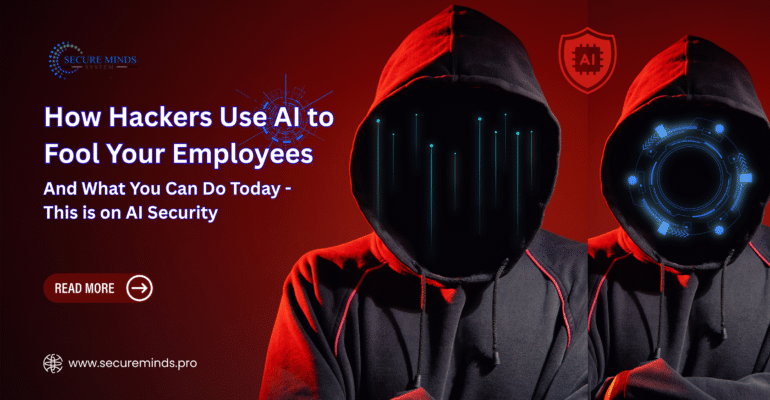AI-Powered Attacks: How to Protect Your Employees

AI-Powered Attacks: How to Protect Your Employees
In the medium of the contemporary high-tech, networked life, artificial intelligence (AI) is transforming the corporate landscape; however, at the same time, it is an opportunity for cybercriminals. While companies are attempting to use AI for greater operational effectiveness, criminals are using the same technological innovations to exploit people. A specific concerning trend is the misuse of AI to trick employees into sharing confidential information or unintentionally granting access to secure systems.
It’s not science fiction. It’s occurring today, and it’s expanding. Unless your company is prepared, it might be next. That’s how cybercriminals employ AI to manipulate, and more importantly, what you can do about it today.
The Rise of Artificial Intelligence Social Engineering
Social engineering, or the power to persuade individuals to circumvent security measures, has existed for a long time. The inclusion of artificial intelligence in the art, though, is a significant advancement.
Phishing emails, once easily identified due to poor language and overly generic messages, have been extensively developed. Some attackers utilise AI technologies to produce well-written and highly personalised messages that impersonate actual colleagues, clients, or even high-level executives. The tactics employed are
Deepfake Voice and Video: The attackers can utilise machine learning to create the voice of a CEO or other executive in order to force them to make emergency wire transfer requests or to give away login credentials.
Chatbot Impersonation: Chatbots can impersonate real conversations and pose as a help desk or IT support to get passwords.
Phishing Accuracy: Sophisticated models like ChatGPT and others can create customised phishing emails within seconds using publicly available data from places like LinkedIn or corporate websites, thus increasing their semblance of credibility and authenticity.
AI helps us eliminate the past “red flags” we’ve learnt to recognise, making it harder to detect phishing.
Business Email Compromise Gets Smarter
Business Email Compromise (BEC) is a major threat that has cost the world billions of dollars in financial loss. The emergence of artificial intelligence has increased the effectiveness and danger of BEC campaigns.
Cyber attackers use AI algorithms to learn the communication patterns of a business, including linguistic and temporal aspects, and thus create extremely realistic-looking emails.
Employees were emailed regularly by machine learning-generated emails that exactly mimicked the tone of their supervisor. The demands specified in the emails were subtle, such as requesting file-sharing privileges, downloading PDFs, or wire transfers. The emails complied precisely with anticipated standards, were delivered immediately, and appeared authentic.
Real-time Targeting and Interpretation
Artificial intelligence-driven translation toolkits allow the attackers to conduct cross-border operations with impunity. Previously, there were foreign-language-written attacks under the previous regime. Nowadays, they are professionally translated, culturally customised, and even locally planned to strike inboxes during working hours.
In addition, AI enables scanning of vast databases involving stolen passwords, company information, or social media posts—to identify lucrative targets of an organisation. The outcome is extremely effective spear-phishing attacks designed for individual employees.
What Can You Do Today?
Learning about how hackers are using AI is only the tip of the iceberg. We all want to know: How do you protect yourself against it? Fortunately, there are steps you can take today to make your defences stronger.
1. Educate Employees with AI-Based Simulations
If your attackers are using AI to generate their messages, you have to use AI to imitate them. You have to use AI-powered phishing simulator tools that imitate real-world attack patterns. This prepares staff for what threats are really out there—not stale samples.
2. Turn on Multi-Factor Authentication
Although credentials can be compromised, MFA will prevent attackers from gaining entry. Enable MFA for all platforms and applications, especially ones involved in financial transactions or holding sensitive data.
3. Zero Trust Framework
Implement a zero-trust model: authenticate users and devices, including internal users. AI-based attacks can use trusted devices or emails; hence, you cannot take anything for granted and must ensure that every piece is thoroughly inspected.
4. Utilize Artificial Intelligence for Defense Purposes
Artificial intelligence is a boon as well as a potential threat. Employ AI tools to detect anomalies in network usage, monitor login activity, and detect suspicious activity. Behavioural AI can alert users to midnight login attempts to utilise resources or from unrecognised locations.
5. Protect Executive Correspondence
Executives are among the most common victims of spoofing. Lock down their email addresses with more controls, and educate them on deepfake threats. Roll out AI-enabled solutions that screen incoming communications for spoofing or synthetic media indicators.
6. Enhance Software and Systems
Artificial intelligence-driven attacks usually rely on the use of previously exploited weaknesses. One must regularly keep all systems patched and up to date to avoid and defend against any weaknesses that future attackers might exploit.
7. Encourage a Culture that Enhances Safety
Develop an organisational culture that motivates employees to report and question suspicious behaviour. Mistakes are a part of any process; however, early intervention will prevent the development of problems. Develop a “see something, say something” culture within the organisation at all levels.
The Future: Arms Race or Opportunity
As artificial intelligence continues to advance, the battle between attackers and defenders will only get fiercer. But this is not a war that is bound to be lost. Organisations that understand the potential vulnerabilities and have proactive countermeasures in place already have the opportunity to gain a competitive edge.
Artificial intelligence is not a tool that cybercriminals have a monopoly over; when used properly, it can be a powerful augmentation of security methods. An investment in training, organisational culture, and equipment that continues to evolve with the evolving form of threats is necessary.
Human capital forms the first line of defence, and when properly empowered, individuals can outmanoeuvre even the most advanced AI-driven attacks.
Conclusion
All in all, cyberattackers are using artificial intelligence to take advantage of the one variable that cybersecurity has always depended on: human error. But knowledge is a kind of empowerment.
By educating yourself on the abuse of AI and by taking measures to strengthen your own AI-driven security solutions, you can protect your organisation from looming attacks.
It is crucial not to wait until your team becomes caught up in a conundrum. Action today, wise training, and strategic use of AI for positive purposes are crucial.
As intelligent cyberattacks loom, human intuition informed by AI may well be your best defence.



